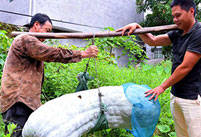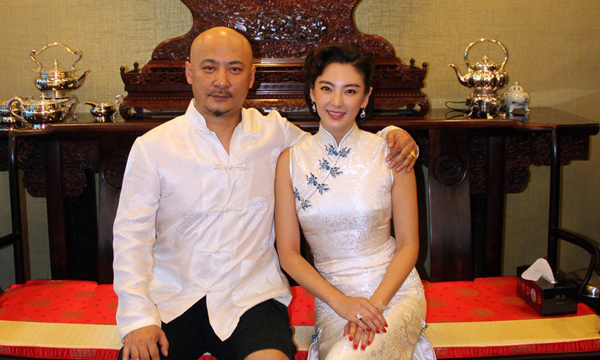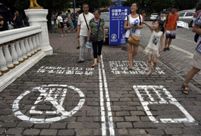 Vintage cars show kicks off in London
Vintage cars show kicks off in London
 Gorgeous scenery in NE China
Gorgeous scenery in NE China
 Picturesque Barkol grassland in Xinjiang
Picturesque Barkol grassland in Xinjiang
 Small Wild Goose Pagoda - A World Cultural Heritage Site along the Silk Road
Small Wild Goose Pagoda - A World Cultural Heritage Site along the Silk Road
 Maritime Silk Road Luxuries of the Han Dynasty
Maritime Silk Road Luxuries of the Han Dynasty
 Ciao! Chinese beauties!
Ciao! Chinese beauties!
 An eye feast: BFA freshmen registration
An eye feast: BFA freshmen registration
 Top 10 most lavish weddings
Top 10 most lavish weddings
 Most amazing chi-pao beauties
Most amazing chi-pao beauties
 Chinese lingerie brand arrives in Las Vegas
Chinese lingerie brand arrives in Las Vegas
 |
| Photo taken on Sept. 15, 2014 shows the porcelain stem cup, cover and stand, discovered from the tomb of the Prince Zhuang of Liang displayed at British Museum, in London, Britain. The British Museum will open an exhibition on Thursday displaying antiques of China's Ming Dynasty. (Xinhua/Han Yan) |
LONDON, Sept. 18 -- The British Museum Thursday opened an exhibition which examines the cultural splendor and diplomatic reach and openness of China during the Ming dynasty.
The exhibition "Ming -- 50 years that changed China" has taken three years to assemble, bringing together 280 objects, with one third of its exhibits on loan from major museums and institutions in China.
Exhibition curator Jessica Harrison-Hall told Xinhua that the show highlighted on the twin themes of Ming courts and their global connections, and focused on the Ming era at its beginning as its source.
She said: "We have taken as our timeframe from the Yongle emperor winning the civil war 1392-1402, setting up his dynasty in 1403 running right through to the Zhengtong emperor being captured by the Mongols in 1449. It is a slice of Ming history and we are looking at how globally connected those courts were at that time."
Through the lens of courts and their global connections a quite different view of Chinese history appears in contrast to the one which many Westerners know.
"People tend to think of China as being quite monolithic -- but in fact it had a bustling translation bureau in Beijing, it had the treasure ships under the auspices of (Admiral) Zheng He going to South East Asia, south Asia, the Middle East and even the east coast of Africa. This is something the Chinese audiences are very familiar with, but which Europeans are less familiar with."
Harrison-Hall said: "Part of the purpose of this exhibition is to expel the popular narrative that Europe discovers China and China awaits to become a globally engaged society. In fact, that is total rubbish, because China was completely engaged at a much earlier period."
She added, "What this period shows that it not just land trade or sea trade, it is both. China is completely plugged in in the early 15th century."
MING PORCELAIN SHOWS CULTURAL FUSION
The Yongle emperor had established his 24 living sons in principalities across China, of which the British Museum has chosen three -- Shandong, Hubei, and Sichuan -- to demonstrate their spread across the country where they also acted as a fence protecting China, said Harrison-Hall.
Symbols of China's commercial and diplomatic reach, and it's interest in other cultures is shown by a display of porcelain vessels used in the courts.
These are in the iconic blue and white porcelain style but they are not characteristic Chinese shapes. Instead the Chinese master craftsmen used the shape and style of Middle Eastern items -- like ewers, paint brush boxes, and incense burners -- to create pieces that take inspiration from Assyria, Egypt and central Asian and combine them with Chinese culture.
"These inspired the form of the Chinese pieces," said Harrison-Hall, as she pointed out a Chinese incense burner whose form was exactly the same as that of a Middle Eastern candlestick, which had been displayed next to it to illustrate the remarkable connection of cultures.
These fusion forms came about in two ways -- first by commission from the emperor and second to meet the high fashion of the elite at the time.
"There was a fashion for foreign forms inspired by the Zheng He naval expeditions," said Harrison-Hall.
"Lots and lots of these vessels have wave borders, alluding perhaps to these ocean voyages," she said.
The martial prowess of court life -- necessary because China had only just thrown off the rule of the Mongols and was often engaged in continuing war with them -- is illustrated in a six-meter long scroll painting.
Harrison-Hall said these scenes show the sports courtiers would have engaged in to keep themselves fit for military service -- including archery, polo and the sports of football and golf, which pre-date the more familiar Western versions of the games by several hundred years.
Visitors will have the unusual opportunity to see a beautiful masterpiece scroll painting by Xia Chang (1399-1470) "Spring Rain on the Xiang River", which is unrolled and displayed to its full 11-meter length.
Such exquisite bamboo scrolls are rarely if ever displayed in full, usually they are rolled out to display one scene at a time. "They would rarely if ever be fully rolled out, to see all 11 meters of it is quite remarkable," explained Harrison-Hall.
The exhibition runs until January 15 next year.
 Giant white gourd weighing 87 kilograms appears in SE China
Giant white gourd weighing 87 kilograms appears in SE China Advanced arms help to safeguard China-ASEAN Expo
Advanced arms help to safeguard China-ASEAN Expo Leading director Wang Quan'an detained for 'buying sex'
Leading director Wang Quan'an detained for 'buying sex' Heaven on earth: Dongjiang Lake in Hunan
Heaven on earth: Dongjiang Lake in Hunan Mixed reaction to smartphone sidewalk
Mixed reaction to smartphone sidewalk 'Rainbow running' race in Jiangxi
'Rainbow running' race in Jiangxi Amazing aerial photos of China's Xisha Islands
Amazing aerial photos of China's Xisha Islands Beautiful postgraduate teaches in remote area
Beautiful postgraduate teaches in remote area Top 10 world's highest-paid models 2014
Top 10 world's highest-paid models 2014 Lingerie show at 2014 Miss China
Lingerie show at 2014 Miss China Songstress Li Xianglan dies at 94
Songstress Li Xianglan dies at 94 Police recruiting posters
Police recruiting posters Anshun Daxi- Living fossil of Chinese drama
Anshun Daxi- Living fossil of Chinese drama Urban farmers in China
Urban farmers in China 'Firepower-2014 Weibei'military exercise
'Firepower-2014 Weibei'military exerciseDay|Week|Month